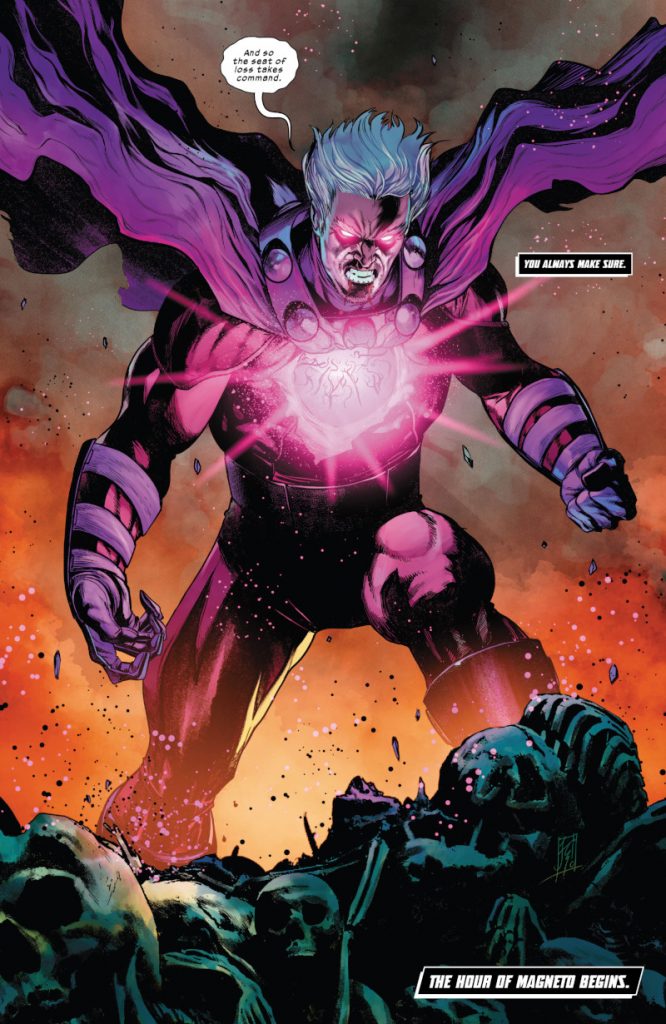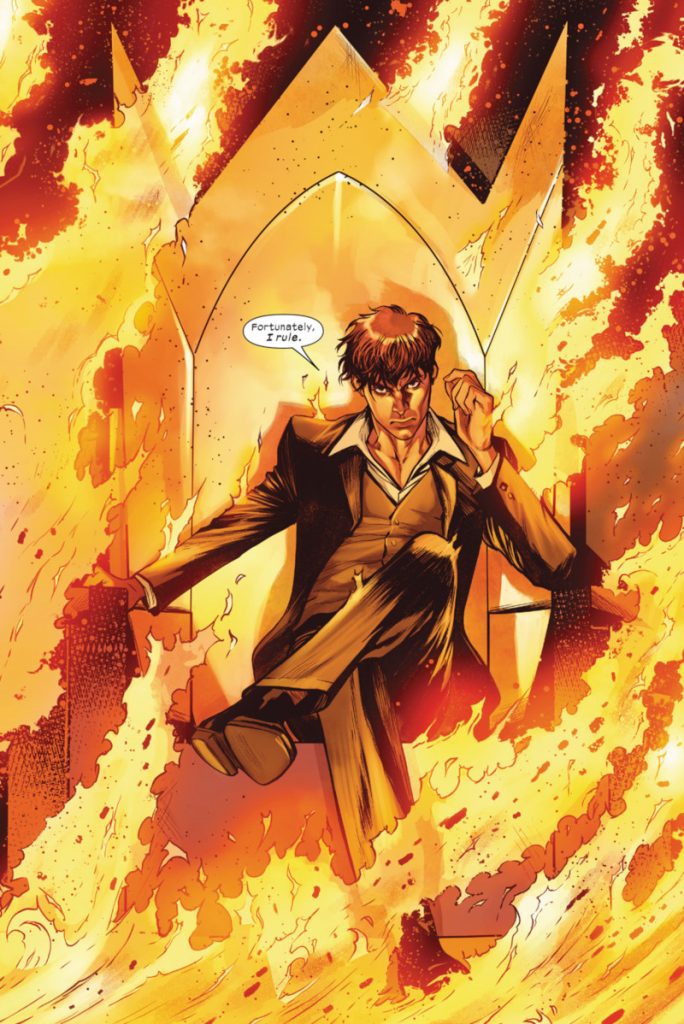The Art of the Page Turn
Page turns are powerful tools in comics. Let's dig into their impact with insight from a gaggle of creators.
What makes a comic book moment pop?
There are a lot of different answers to that question, both because there are plenty to choose from and because many – maybe even all – of them are purely subjective. Different things work for different readers. What moves you might not move someone else.
But for me, those forms often arrive as massive moments that thrill and delight. Those highlight reel hits that make you want to bump your fist or curse the creative team’s name, sometimes at the same time. My mind quickly turns to X-Men Red for recent examples of that. That title is a wall-to-wall mic drop factory, as writer Al Ewing and artistic partners like Stefano Caselli team to deliver beats that sear themselves into our brains and energize our hearts in equal measure.
For example, there was the way the dialogue and narration combine with the visuals in X-Men Red #5, as Caselli’s mortally wounded yet still-standing Magneto declares, “And so the seat of loss takes command” while the issue-long narration emphasizes once more, “YOU ALWAYS MAKE SURE.” 8 Or that part in #9 when an on point and on fire Roberto Da Costa is revealed to be who is truly sitting on a besieged throne instead of now-presumably deceased Shi’ar ruler Xandra Neramini, with Sunspot noting in the purest form of his casual bravado, “Fortunately, I rule” to shocked onlookers.


Those two beats are electric, pantheon level moments from superhero comics in 2022, ones you can immediately point to as examples of why X-Men Red is a best-in-class book. But those killer moments don’t just pop because they’re brilliantly drawn splash pages that you can’t stop thinking about. That’s crucial, the payoff of a promise made. But an essential reason they hit as hard as they do is a component that often happens without consideration as we read: the turn of the page.
It’s possible some readers don’t even think about the page turn as we interact with these stories. It’s comic book locomotion, an action that can be as mindless as the swipe of a smart phone screen and just as perpetual when it comes to our engagement with the medium. That’s not to say some readers don’t consider turns as they read. But it’s often for their utility, a necessary movement to continue reading. And sure, it does have utility…but it’s also a key part of the artform itself, as many creators told me.
“It is the most important tool we have in the toolbox,” writer Torunn Grønbekk said.
“Page turns are crucial,” cartoonist Kyle Starks added.
“I love the page turn,” writer Kelly Thompson shared. “I try to make the most of it as it’s one of the only tools we have as creators to dictate how readers read.”
That last point Thompson made is important. It was also a common emphasis as to why page turns are so essential. Comic readers naturally turn and look at both pages in full before engaging with the panels that comprise them. This guarantees that anything not protected by the page turn will immediately be sniffed out, with whatever secrets hidden on the page being revealed well before a reader gets to them in the process of reading, harming the impact of the moment in the process. This is a characteristic unique to comics. As Starks put it, “it’s all on the page” with comics, making it difficult to “hide anything on a page or a spread.” The page turn protects that information until the reader makes the turn themselves.
“It’s kind of the only real unknown you have to work with in the medium,” Starks said.
So, we know they’re powerful tools. But what exactly is a page turn?
It’s when you turn a page in a comic. Obviously.
Okay, maybe it’s a bit more than that. A page turn isn’t just a physical movement. It can be a lot of things, like when I described one of those X-Men Red splashes as “the payoff of a promise made.” If the splash is the payoff, then the turn is part of the promise storytellers make to readers. It’s something that says, “When you turn this page, all will be revealed.” That’s a powerful feeling to inspire.
More than that, a page turn is something that “offers either a completion or a continuation,” as cartoonist Brenna Thummler put it. While those may sound like two opposing ideas, they stand true together because of the interactivity of the comic reading experience.
“A page turn is an invitation that a reader need not accept, and it’s the author’s job to make them want to,” Thummler added. “In this way, the reader is a participant in the story, ultimately deciding whether to move on.”
Readers make that choice dozens or even hundreds of times in the process of reading a single comic or graphic novel. Unlike with prose too, Thummler noted that it falls upon comic creators to make a “deliberate decision” about what leads into each page turn and what comes out of it. After all, the words just fall where they lie in a novel. 9 Comic turns come down to careful choices, ones that could determine whether a scene or even comic works at all. If you don’t fulfill that promise, you may lose storytelling momentum. That’s a key downside to page turns, writer Kieron Gillen emphasized.
“A page turn is where a reader is taken out of the narrative for a second. They have to move from just using their eyes to also using their hands and having a gap in the story experience,” Gillen shared. “As such, you at least consider making sure that you create enough narrative propulsion to carry someone across the gap.”
That’s an important note. In some ways, every page turn is a choose your own adventure story. Even if a creator intends one to act as a continuation, the reader may decide it’s where their journey ends if they’re not properly incentivized to move onwards. And there are ways to create that propulsion Gillen spoke of.
subscribers only.
Learn more about what you get with a subscription
“The Hour of Magneto Begins” in the bottom right corner acts as a delectable coda to it as well.↩
At least for the most part.↩
Like in the above pages from The Wicked + The Divine #11, which Gillen said earned “the biggest gasp” of any page turn he ever wrote.↩
Brian K. Vaughan and Fiona Staples’ Saga is one of the best at this. Each issue opens and closes with a page turn followed by a splash page. This is where it’s worth mentioning that the first page turn actually happens when you open the cover. That’s maybe the most underrated page turn and Saga is one of the few that takes advantage of it!↩
Starks cited Joe Hill and Gabriel Rodriguez’s Locke & Key and Thompson referenced Scott Snyder and Francesco Francavilla’s work in the Detective Comics storyline The Black Mirror as two books that got it right.↩
Which makes sense, because double page spreads, by nature, always have to be preceded by a turn.↩
Who Gillen believes got it from writer Brian Michael Bendis.↩
“The Hour of Magneto Begins” in the bottom right corner acts as a delectable coda to it as well.↩
At least for the most part.↩
